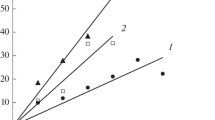Abstract
Oil sorbents based on carbon-containing waste of coal, woodworking enterprises and active sludge of biological treatment facilities were developed at the Department of Chemical Technology of Solid Fuel T. F. Gorbachev Kuzbass State Technical University. These sorbents performed well for water cleaning from oil, but they have low strength. Hardening methods of the developed granules are proposed and their influence on the characteristics of oil sorbents, such as moisture, ash content, density, volatile yield substances, compressive strength, as well as moisture and oil capacity were studied in this article.
Access this chapter
Tax calculation will be finalised at checkout
Purchases are for personal use only
Similar content being viewed by others
References
Bannov A, Varentsov V, Chukanov I, Gorodilova E, Kuvshinov G (2012) Comparative analysis of methods of oxidative modification of carbon nanofibers. Prot Met Phys Chem Surf 48:199–206
Bentz D, Garboezi E, Haecker C, Jensen O (1999) Effect of cement particle size distribution on performance properties of portland cement-based materials. Cem Concr Res 29(10):1663–1671
Björklund K, Li L (2016) Estimation of rock physics properties from seismic attributes. Water Sci Technol 4:35–53
Blais JM, Rosen M, Smol JP (2015) Environmental contaminants, 18th edn. Springer, Netherlands
Clarke M (2003) Encyclopedia of food sciences and nutrition, 2nd ed. Springer Academic Press
Coal briquettes. Method for the determination of water absorption homepage. http://docs.cntd.ru/document/1200024248. Last Accessed 06 Mar 2021
Ghiurea M, Dima S, Turcanu A, Fierascu R, Nicolae C, Trica B, Oancea F (2010) Carbonaceous nanostructures obtained by hydrothermal conversion of biomass. Proceedings 22:813–828
Hu B et al (eds.) (2010) Carbonaceous nanostructures obtained by hydrothermal con-version of biomass, Adv Mater 22:813–828
Kitaeva N, Bannova E, Alekseeva M, Merkov S, Llicheva N (2015) Adsorption properties of carbon sorbents based on carbonized peat. Biosci Biotechnol Res Asia 12(3):2393–2403
Kugatov P, Bashirov I, Zhirnov B (2016) Production of a mesoporous carbon adsorbent from carbon black and petroleum pitch by high-temperature roasting and steam activation. Coke Chem 59(9):345–348
Kvashevaia E, Ushakova E, Ushakov A (2015) Carbon-containing waste of coal enterprises in magnetic sorbents technology. In: The second International innovative mining symposium 2015, vol 21. Springer, Kemerovo, pp 1–7
Kuvshinov G et al (eds) (1999) Comparative analysis of methods of oxidative modifi-cation of carbon nanofibers. Carbon 37:1239–1246
Lemes P, Soto-Oviedo M, Waldman W, Innocentini-Mei L, Duran N (2010) Effect of lignosulfonate on the thermal and morphological behavior of poly(3-hydroxybutyrate-co-3-hydroxyvalerate). J Polym Environ 18:250–259
May H, Kenichiro N, Sohei N (2019) Durability index for quality classification of cover concrete based on water intentional spraying tests. Cement Concr Compos 104:54–67
Paul A, Ezeh E, Gimba E, Arthur D (2014) Comparative study of phenol formaldehyde and urea formaldehyde particleboards from wood waste for sustainable environment. Int J Sci Technol Res 3(9):53–61
Runliang Z, Qingze C, Qing Z, Yunfei X, Jianxi Z, Hongping H (2016) Adsorbents based on montmorillonite for contaminant removal from water: a review. Applied Clay Sci 123:239–258
Solid mineral fuels. Methods for determination of ash homepage. http://docs.cntd.ru/document/gost-11022-95. Last Accessed 06 Mar 2021
Solid mineral fuel. Methods for determination of volatile matter yield homepage. http://docs.cntd.ru/document/1200029223. Last Accessed 06 Mar 2021
Sorbents. Method for determination of moisture fraction of total mass in activated carbons and catalysts on their base homepage. http://docs.cntd.ru/document/1200017238. Last Accessed 06 Mar 2021
Ushakova E, Kvashevaya E, Ushakov A (2018) Innovative environment-saving technology using magnetic sorbents based on carbon-containing waste from coal. In: IIIrd international innovative mining symposium 2018, vol 41. Springer, Kemerovo, pp 36–40
Author information
Authors and Affiliations
Corresponding author
Editor information
Editors and Affiliations
Rights and permissions
Copyright information
© 2021 The Author(s), under exclusive license to Springer Nature Switzerland AG
About this paper
Cite this paper
Ushakova, E., Soloveva, L., Ushakov, A. (2021). Comparison Methods of Carbon Oil Sorbents Hardening. In: Jeon, HY. (eds) Sustainable Development of Water and Environment. ICSDWE 2021. Environmental Science and Engineering. Springer, Cham. https://doi.org/10.1007/978-3-030-75278-1_25
Download citation
DOI: https://doi.org/10.1007/978-3-030-75278-1_25
Published:
Publisher Name: Springer, Cham
Print ISBN: 978-3-030-75277-4
Online ISBN: 978-3-030-75278-1
eBook Packages: Earth and Environmental ScienceEarth and Environmental Science (R0)




